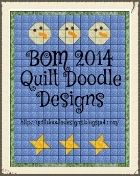Here we are, after a little break to stretch our fingers, back to the applique tutorial. At this point, all of our pieces are prepared--the fabric is ironed onto the freezer paper and the raw fabric edges have been ironed under and are stiffened with starch. Time to talk a little bit about the other important part of the applique block: the background.
Some designers like to keep their backgrounds simple and some designers like to design pieced backgrounds. For instance, Anne Sutton of Bunny Hill often designs pieced backgrounds, while the Shabby Fabrics/Country Cottages blocks I've shown you are all of one piece.
For backgrounds that are all of one piece, I like to cut them a little larger than the pattern specifies and trim them to size after I've added the applique. Why? Because the process of stitching the applique to the background, often in layers, tends to shrink and slightly distort the background fabric a bit, so by cutting it larger than needed, I have an opportunity at the end to trim the block to the right size.
With pieced backgrounds, there aren't any good options--we simply need to piece the background as directed by the designer. On the positive side, pieced backgrounds often lend more interest to the finished quilt. On the negative side, after it's appliqued, the block may not be exactly the correct size, so we need to take a little extra care in adding the applique to ensure the background isn't distorted.
Another question we must consider is whether to trace the applique design onto the background. Designers usually include a layout page showing where each piece belongs on the background, and using a light box, the layout can be traced onto the background. Alternatively, we can simply eyeball the position of the pieces when we "audition" the layout on the background. Normally I make the second choice and lay out the applique pieces where it looks like they go. Why? Because it often seems that when I trace the pattern onto the background, the pieces don't line up just perfectly and my choices to correct the problem are somewhat limited. I have, in the past, ended up completely re-doing applique pieces so they will fit better, and that feels like wasted time to me!
Now that we have backgrounds figured out, let's get back to the next part--the glue part. Here's what I use--a water soluble applique glue and wooden toothpicks to apply the glue. That's it.
Using the water soluble glue means that I can wash the glue out if I make a mistake. It should also wash out of the finished product later. I like that.
Before I start, I like to lay out all the applique pieces in the position they'll go in--just like I laid out the freezer paper pieces before. Once I've made sure I have all the pieces, they all fit together, and the fabrics are correct, I'm ready to begin. First, we need to remove the freezer paper. I do that piece by piece, just as I'm ready to use it.
The starch should hold the edges under, but they can be touched up with the iron before gluing if the seams aren't flat.
Next, lay a few pieces in place--and remember to check back to the pattern to see if the pieces are numbered because you'll want to start by positioning piece number 1, followed by piece number 2, then piece number 3, etc.
When you know where the piece will go, apply a slight bit of glue along the seam allowance. Don't apply the glue too close to the folded edge, though, because you'll need to applique the edge, and pushing a needle through dried glue isn't easy. And be sparing with the glue--you just need enough to hold the pieces into place for sewing--think about how pins will secure something without pinning every little bit, right?
You might want to glue a couple pieces in place and then applique those pieces before moving on. Or you might want to glue ALL the pieces in place before sewing them down. Much of the time, I glue first and then sew. Here's a photo of an Autumn House block with all the pieces glued into place and ready for stitching:
And that pretty much concludes all of the prep work for the freezer paper and starch method of applique. Would you like me to do a post or two about hand applique, techniques, and tips? I'm not an expert, but I've taken some classes and might know a thing or two I can share. Let me know if you'd like to hear more.































